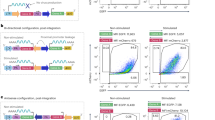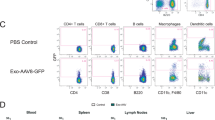Abstract
Cell type-specific gene delivery will be essential for in vivo gene therapy. Our laboratory has previously developed retroviral vector particles, derived from spleen necrosis virus, SNV, which display the antigen-binding site of an antibody on the viral surface. Such particles infected only human cells in vitro, which expressed a receptor recognized by the antibody. To test cell type-specific gene delivery in vivo, a mouse model system has been developed. Antibiotic resistant human target and non-target cells were injected into the peritoneum of SCID mice. Subsequently, a vector solution containing 106 infectious particles, which display scAs against the human her2neu cell surface protein, was injected. Cells were recovered from the peritoneum, subjected to antibiotic selection, and tested for the expression of a lacZ gene transduced by the retroviral vector. We found that human target cells, which express her2neu, were infected in vivo. However, neither human cells that do not express her2neu, nor normal mouse cells were infected by such viral particles. These data give proof of principle that retroviral vector-mediated, cell type-specific gene delivery can be obtained in vivo.
This is a preview of subscription content, access via your institution
Access options
Subscribe to this journal
Receive 12 print issues and online access
$259.00 per year
only $21.58 per issue
Buy this article
- Purchase on Springer Link
- Instant access to full article PDF
Prices may be subject to local taxes which are calculated during checkout



Similar content being viewed by others
References
Miller AD . Retrovirus packaging cells Hum Gene Ther 1990 1: 5–14
Anderson WF . Human gene therapy Nature 1998 392: 25–30
McCormack JE et al. Anti-vector immunoglobulin induced by retroviral vectors Hum Gene Ther 1997 8: 1263–1273
Hunter E, Swanstrom R . Retrovirus envelope glycoproteins Curr Top Microbiol Immunol 1990 157: 187–253
Young JAT, Bates P, Willert K, Varmus HE . Efficient incorporation of human CD4 protein into avian leukosis virus particles Science 1990 250: 1421–1423
Chu T-H, Dornburg R . Retroviral vector particles displaying the antigen-binding site of an antibody enable cell type-specific gene transfer J Virol 1995 69: 2659–2663
Chu T-H, Martinez I, Sheay WC, Dornburg R . Cell targeting with retroviral vector particles containing antibody-envelope fusion proteins Gene Therapy 1994 1: 292–299
Russell SJ, Hawkins RE, Winter G . Retroviral vectors displaying functional antibody fragments Nucl Acid Res 1993 21: 1081–1085
Chu T-H, Dornburg R . Towards highly efficient cell type-specific gene transfer with retroviral vectors that display a single chain antibody J Virol 1997 71: 720–725
Jiang A et al. Cell type-specific gene transfer into human cells with retroviral vectors that display single-chain antibodies J Virol 1998 72: 10148–10156
EngelstaÐdter M et al. Targeting human T cells by retroviral vectors displaying antibody domains selected from a phage display library Hum Gene Ther (in press)
Bird RE et al. Single-chain antigen-binding proteins Science 1988 242: 423–426
Whitlow M, Filpula D . Single-chain Fv proteins and their fusion proteins Meth Enzymol 1991 2: 1–9
Alper O et al. The presence of c-erbB-2 gene product-related protein in culture medium conditioned by breast cancer cell line SK-BR-3 Cell Growth Diff 1990 1: 591–599
Uckun FM . Severe combined immunodeficient mouse models of human leukemia Blood 1996 88: 1135–1146
Dick JE . Future prospects for animal models created by transplanting human haematopoietic cells into immune-deficient mice Res Immunol 1994 145: 380–384
Dick JE, Sirard C, Pflumio F, Lapidot T . Murine models of normal and neoplastic human haematopoiesis Cancer Surv 1992 15: 161–181
Dick JE . Immune-deficient mice as models of normal and leukemic human hematopoiesis Cancer Cells 1991 3: 39–48
Mueller BM, Reisfeld RA . Potential of the SCID mouse as a host for human tumors Cancer Metast Rev 1991 10: 193–200
Shen RN, Lu L, Broxmeyer HE . New therapeutic strategies in the treatment of murine diseases induced by virus and solid tumors: biology and implications for the potential treatment of human leukemia, aids, and solid tumors (review) Crit Rev Oncol Hematol 1990 10: 253–265
Taylor HW, Olson LD . Spectrum of infectivity and transmission of the T-virus Avian Dis 1972 16: 330–335
Welsh RM, Cooper NR, Jensen FC, Oldstone MBA . Human serum lysis RNA tumor viruses Nature 1975 257: 612–614
Welsh RM, Jensen FC, Cooper NR, Oldstone MBA . Inactivation and lysis of oncornaviruses by human serum Virology 1976 74: 432–440
Takeuchi Y et al. Type C retrovirus inactivation by human complement is determined by both the viral genome and the producer cell J Virol 1994 68: 8001–8007
Russell DW, Berger MS, Miller AD . The effects of human serum and cerebrospinal fluid on retroviral vectors and packaging cell lines Hum Gene Ther 1995 6: 635–641
Takeuchi Y et al. Type c retrovirus inactivation by human complement is determined by both the viral genome and the producer cell J Virol 1994 68: 8001–8007
Mikawa T, Fischman DA, Dougherty JP, Brown AMC . In vivo analysis of a new lacZ retrovirus vector suitable for lineage marking in avian and other species Exp Cell Res 1992 195: 516–523
Pomerantz RJ, Trono D . Genetic therapies for HIV infections: promise for the future AIDS 1995 9: 985–993
Kawai S, Nishizawa M . New procedure for DNA transfection with polycation and dimethyl sulfoxide Mol Cell Biol 1984 4: 1172–1174
Martinez I, Dornburg R . Improved retroviral packaging lines derived from spleen necrosis virus Virology 1995 208: 234–241
Acknowledgements
We would like to thank Dr R Pomerantz and Dr M Schnell at Thomas Jefferson University for helpful comments on this manuscript. This work was supported by grants obtained from Baxter Healthcare and the National Institute of Health (1RO1AI41899–01).
Author information
Authors and Affiliations
Rights and permissions
About this article
Cite this article
Jiang, A., Dornburg, R. & Dornburg, R. In vivo cell type-specific gene delivery with retroviral vectors that display single chain antibodies. Gene Ther 6, 1982–1987 (1999). https://doi.org/10.1038/sj.gt.3301043
Received:
Accepted:
Published:
Issue Date:
DOI: https://doi.org/10.1038/sj.gt.3301043
Keywords
This article is cited by
-
Targeting lentiviral vector to specific cell types through surface displayed single chain antibody and fusogenic molecule
Virology Journal (2010)
-
Lentiviral vector retargeting to P-glycoprotein on metastatic melanoma through intravenous injection
Nature Medicine (2005)
-
Spleen necrosis virus-derived C-type retroviral vectors for gene transfer to quiescent cells
Nature Biotechnology (2000)



